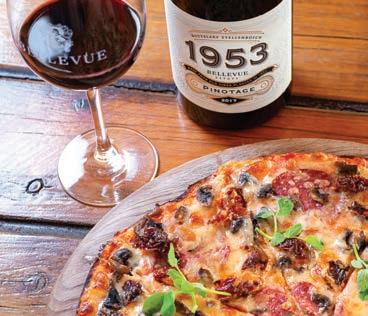
26 minute read
DAVE BIGGS ON DRY WINE
Is Dry Farming the FUTURE?
David Biggs raises an admiring glass to the country’s dry farmers
Advertisement
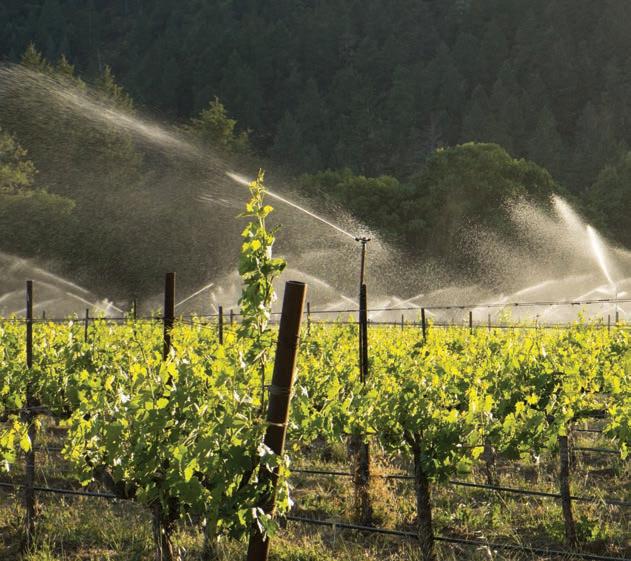
One of the basic requirements of farming—any branch of farming—is to nd the best conditions in which to practise your branch of agriculture. Each patch of our planet’s surface has its unique properties in terms of soil type, climate, rainfall, altitude and latitude. e arid Karoo with its low rainfall is ideal for sheep and goat farming because the natural vegetation is mostly tough scrub suitable for sustaining small stock. A “Mediterranean” climate is good for citrus farming. Grass covered, rolling prairie country is best suited for cattle ranching. e Western Cape, with its winter rainfall for growth and its warm ripening summers, has proved ideal for grape growing, and hence for wine production.
In today’s world, we hear increasing reports of climate change, global warming and the need for natural and “organic” farming methods. In the past, little thought has been given to the amount of water required to produce the wines we love. ere’s always been enough. Times are changing. Despite the Covid-19 pandemic, the Western Cape’s population has grown rapidly in recent years and this has created a huge new demand for domestic water. Add to this the problem of global warming, which is reducing the supply of naturally available water. ere could be a crisis looming.
In wine-producing areas around the world, the idea of “dry farming” is looking increasingly attractive. is consists, basically, of cutting down on arti cial irrigation (drip and spray) and encouraging your vines to send their roots deep into the earth in search of natural moisture. In many Old World wine countries like Italy, Greece and France dry farming has always

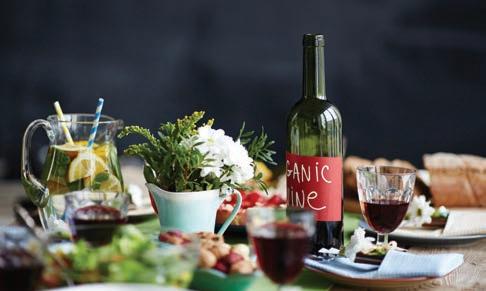



been the way things are done. Farmers in California’s Napa Valley have been dry farming since the 1920s. It makes good sense, not only from a conservation point of view but also from a quality angle.
With irrigated vines, it takes about 110 litres of water to produce a glass of wine. It is estimated that dry-farmed vines use only about ve litres to make that glass-full. Irrigated vines produce large, juicy grapes, whereas dry-farmed vines deliver much smaller berries. e ratio of skin area to the pulp is very di erent in each style of grape. Much of the avour a wine—and in red wines all of the colour—is derived from the grape skins. As expected, dry-farmed grapes produce intense avours and deep colour. is is why many of the world’s best port wines come from unirrigated vines.
In South Africa, the best-known dry-farmed wines are probably from the Swartland area, also known as a wheatfarming region. Innovative winemakers like Adi Badenhorst of AA Badenhorst Family Wines have used these intensely avoured grapes to produce unique and exciting wines like his Grenache, Palomino and his unique Funky White Wine, a blend of no fewer than 11 grape varieties. For those who prefer wines in a lighter style, Adi’s Secateurs range is a friendly collection of drinks consisting of a red blend, a Chenin Blanc and a rosé: lighter, but with that assertive individually that originates deep in the earth.
Another distinctive range of dry-farmed wines, also from the Swartland area, is that from Allesverloren. Owned by the Malan family, Allesverloren has been producing wines since 1800 and—hardly surprising—has become known for its Portuguese grape varieties like Touriga Nacional, Souzao and Tinta Barocca. e cellar produces several port-style wines as well as a gutsy forti ed Red Muscadel (17% alcohol) and unusual rosés from Tinta Barocca. When the rst Malan to own the farm bought it in 1872 it was known as a wheat farm but it was the powerful, deep-rooted vines that clinched the sale. Daniel Malan was obviously a man of vision. Less well known, but equally devoted to the concept of minimal intervention, are the Mullineux and Leeu Family wines based in the RiebeekKasteel area. Acknowledging the importance of the soil in which the vines are grown, the family named their wines a er the rock formations under the vineyards, so their range includes Granite Syrah, Schist Syrah and Quartz Chenin Blanc. Although not widely available in South Africa the Mullineux and Leeu wines are appreciated by connoisseurs in more than 20 countries worldwide.
South Africa’s diverse population results in widely di ering wine requirements. ere’s a steady demand for cheap, massproduced “generic” wines. Luckily our industry is able to satisfy this demand. But at the top end of the social ladder there are sophisticated, widely travelled connoisseurs who have honed their palates on the nest wines the world can produce. ese are the target customers for those winemakers who search deep into the heart of the earth to nd perfection. Raise an admiring glass in a toast to the country’s dry farmers.
RECIPES | TIKTOK TRENDS WHEN GIVES lemonslifeYOU
Six trendy TikTok recipes to try

Dalgona Coffee with Honeycomb
Despite having several (more like fourteen, but who’s counting?) unsettling months due to a certain pandemic, this turbulent time has certainly inspired us to get creative in ways we never knew we could. Yup, we’ve taken those sour lemons and turned them into sweet, sweet lemonade.
Thanks to the huge rise in TikTok, we’ve seen an influx of thousands and thousands of unique and wildly creative food recipes to try at home. (Ahem, for those living under a rock, TikTok is a social media platform used to make a variety of short-form videos that have a duration from 15 seconds to one minute.)
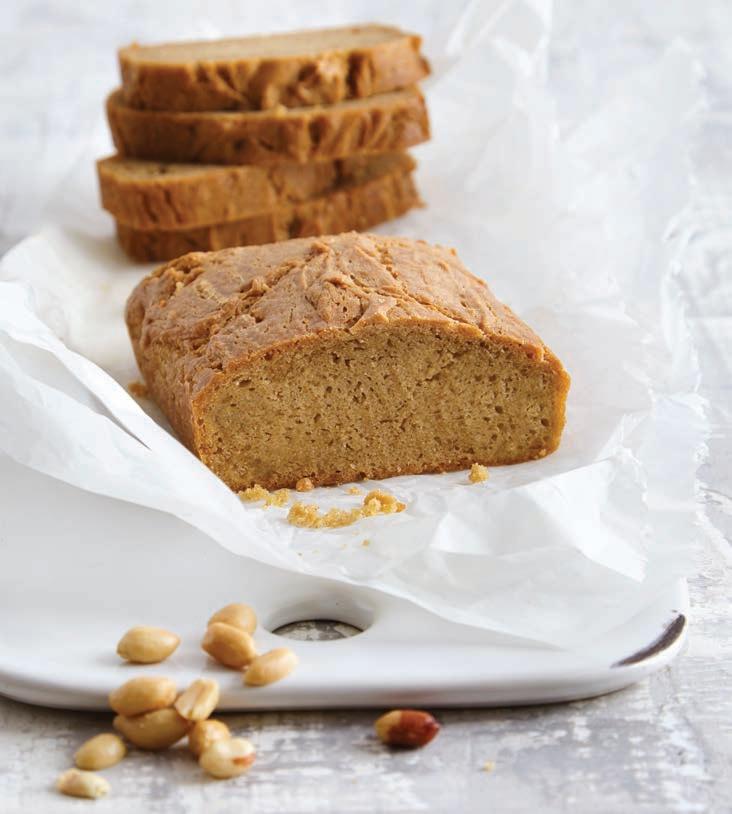
Here, we share six of our favourite tried-andtested TikTok inspired recipes for you to try at home. Enjoy!
DALGONA COFFEE WITH HONEYCOMB Serves 2
INGREDIENTS:
500ml semi-skimmed milk 3 tbsp instant espresso powder (instant coffee) 2 tbsp caster sugar 2 tbsp honey 1 pinch ground cinnamon 2 - 3 tbsp dry honeycomb, broken into pieces
METHOD:
1. Gently warm the milk in a saucepan set over medium heat; do not boil. 2. Meanwhile, combine the espresso powder, sugar, honey, and cinnamon with 4 tbsp boiling water in a mixing bowl. Whip with an electric mixer until frothy, 2-3 min; if desired, use a milk frother to froth the mixture at the end. 3. Divide the warm milk between two glasses; topped with the frothed coffee mixture and garnish with honeycomb.
As in real life, TikTok times are all about the coffee. Plus, tiktokers (Yes, that’s a word now) are also all for cooking crafts and their fun possibilities. Dalgona coffee, also known as whipped coffee, has its roots in South Korea, where the sweet treat was popular in the 70s and 80s. TikTok served to revive this icy coffee classic and now all the cool kids are drinking them. FLOURLESS PEANUT BUTTER BREAD Serves 12
INGREDIENTS:
375g | 1 ½ cups smooth peanut butter, no added sugar 5 large eggs 1 ½ tbsp white vinegar ¾ tsp bicarbonate of soda 2 tsp granulated sweetener
METHOD:
1. Preheat the oven to 180°C (160° fan). Grease and line a 900g loaf tin with parchment paper.
Flourless Peanut Butter Bread
Who doesn’t love a low-carb / banting /keto-friendly recipe? It’s all the fun without the loaded calories and dreaded post-carb coma. A nutty twist on the banana bread Instagram fad, this recipe is simple, moist and oh-so-fluffy.
2. Combine all the ingredients in a large mixing bowl. Beat well with an electric mixer until smooth and even. 3. Pour and scrape into the loaf tin; rap on a flat surface to help settle the batter. 4. Bake until risen and dry to the touch, 35-45 min; a toothpick should come out clean from the centre when ready. 5. Remove the tin to a wire rack. Let the bread cool completely before turning out, slicing, and serving.
PANCAKE CEREAL WITH BANANA AND HONEY Serves 4
INGREDIENTS:
4 large eggs ½ tsp salt 400ml milk 100ml buttermilk 120g | 1 cup plain flour 2 tsp caster sugar 2 - 3 tbsp unsalted butter, cubed, for frying
To serve:
2 bananas, sliced cold milk honey
METHOD:
1. For the pancakes: Combine everything, apart from the butter, in a food processor or blender. Blend on high until a smooth batter forms, scraping down the sides of the processor as needed. 2. Chill the batter for 30 min. 3. After chilling, preheat a non-stick frying pan over medium heat until hot. Add a cube of butter, letting it melt before adding small ladles of batter to the pan, spaced apart. 4. Cook until set and browned underneath, about 1 minute. Carefully flip and cook the other side for 30-45 seconds before sliding out of the pan onto a plate and covering with foil to keep warm. 5. Repeat steps 3 & 4 for the remaining pancakes, keeping them warm under the foil. 6. To serve: When ready to serve, divide the pancakes and banana between bowls; serve with milk and honey.
Mini pancakes in a bowl full of milk and eaten like cereal? So crazy, it makes complete sense, don't you think? Whip up this fun recipe, grab your spoon and your oat milk and head to the couch for a serious session of Netflix and chill.
Pancake Cereal

CLOUD BREAD SANDWICH WITH FETA AND ROCKET SALAD Serves 2
INGREDIENTS:
For the cloud bread:
4 large eggs, separated 60g | ¼ cup cream cheese, softened 1 pinch salt ¼ teaspoon cream of tartar 15g | ½ cup flat-leaf parsley, chopped cooking spray, olive or coconut oil
To assemble:
4 tbsp mayonnaise 375g feta, sliced 2 vine tomatoes, cored and sliced 50g | 2 cups baby spinach 50g | 2 cups rocket
METHOD:
1. For the cloud bread: Preheat the oven to 150°C (130° fan). 2. Beat together the eggs yolks and cream cheese in a mixing bowl until smooth. 3. In an oil-free mixing bowl, whip the egg whites with a pinch of salt and the cream of tartar to soft, fluffy peaks. 4. Very carefully fold the egg whites into the egg yolk mixture using a spatula, trying to retain as much air in the mixture as possible. Fold in the chopped parsley. 5. Spray two large baking trays with cooking spray. 6. Spoon four even mounds of the mixture onto the sheets, well-spaced apart. Spread out into half-moon shapes with a damp, off-set spatula. 7. Bake for 35-50 min until the slices are set golden in colour. Remove from the oven and let cool completely on the trays. 8. Once completely cool, transfer to large freezer bags and seal well. Leave to rest overnight. 9. To assemble: Spread the cloud breads with mayonnaise. Top two slices with feta, tomato, baby spinach, rocket, and then close with the remaining two slices, mayonnaise-side facing down, to complete.
POKE BOWL WITH CELERY, BROCCOLINI, GREEN ASPARAGUS AND KIMCHI Serves 4
INGREDIENTS:
250g | 1 ½ cups sushi rice, rinsed in several changes of water, then drained 225g | 2 cups broccoli spears, trimmed 225g | 2 cups asparagus, woody ends removed 2 tbsp seasoned rice vinegar 4 celery stalks, cut into sections 150g | 1 cup mixed cherry tomatoes, halved 25g | 1 cup purple alfalfa sprouts 240g | 1 cup kimchi* 1 tbsp chia seeds 1 tbsp brown flax seeds salt freshly ground black pepper
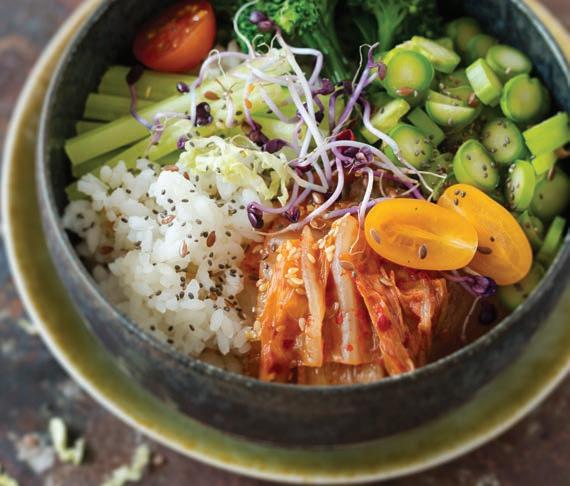
For the kimchi:
1 Chinese cabbage 3 garlic cloves, crushed 2.5cm piece ginger, grated 2 tbsp fish sauce (optional) 2 tbsp sriracha chilli sauce 1 tbsp golden caster sugar 3 tbsp rice vinegar 8 radishes, coarsely grated 2 carrots, cut into matchsticks or coarsely grated 4 spring onions, finely shredded
METHOD:
1. For the kimchi: Slice the cabbage into 2.5cm strips. Tip into a bowl, mix with 1 tbsp sea salt, then set aside for 1 hr. 2. Meanwhile, make the kimchi paste by blending the garlic, ginger, fish sauce (if using), chilli sauce, sugar and rice vinegar together in a small bowl. 3. Rinse the cabbage under cold running water, drain and dry thoroughly. Transfer to a large bowl and toss through the paste, along with the radishes, carrot and spring onions. 4. Serve straight away or pack into a large jar, seal and leave to ferment at room temperature overnight, then chill. Will keep in the fridge for up to 2 weeks - the flavour will improve the longer it's left. 5. For the poke bowl: Place the drained sushi rice in a saucepan with 550ml water. 6. Bring to the boil over medium heat, cover, and gently simmer over low heat until the rice has absorbed the water, 15-20 min. 7. Remove from the heat and set aside to cool, still covered, for at least 10 min. 8. Meanwhile, place the broccoli and asparagus in a steaming basket. Cover and steam over a half-filled saucepan of simmering water until just tender to the bite, about 3 min. 9. Drain and let cool briefly. Cut the asparagus into thin pieces. 10. Fluff the rice with a fork; sprinkle with the vinegar and season with salt and pepper, stirring to combine. 11. To serve: Divide the rice, steamed vegetables, celery, tomatoes, sprouts, and kimchi between bowls. Sprinkle with chia seeds and flax seeds.
Hot on the tails of the ever-growing vegan/ vegetarian lifestyle choice, this plant-based poke bowl also pays homage to an equally popular craze of including gut-healthy fermented foods in your diet. With the addition of kimchi, a traditional Korean cuisine made with fermented cabbage, this recipe is trending two fold.
When a recipe for bread goes viral, you know you are living in interesting times. This isolation-inspired bread is made with just three basic ingredients, resulting in heavenly, fluffy, and deliciously airy bread.
Cloud Bread Sandwich
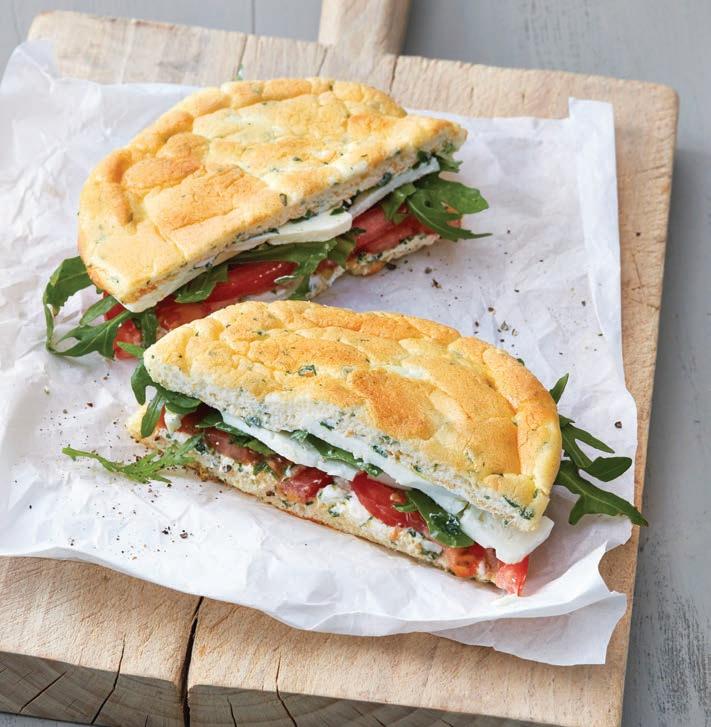
HOMEMADE HAZELNUT SPREAD Makes 1 jar
INGREDIENTS:
450g | 3 cups raw hazelnuts 150g caster sugar 250ml water ½ tsp vanilla extract
METHOD:
1. Preheat the oven to 200°C (180° fan). Spread out the hazelnuts in a single layer on a large rimmed baking tray; if needed, divide between two trays. 2. Place in the oven and roast until golden brown, 6-8 min. 3. Remove and transfer to a heavy-based saucepan; add the sugar and water. 4. Bring to a boil over moderate heat and then reduce to a simmer until most of the water has evaporated, 25-35 min. 5. Remove from the heat and stir in the vanilla. Strain the hazelnuts and transfer to a food processor or blender; reserve the syrup in the pan. 6. Blend the hazelnuts until smooth, loosening with a little of the reserved syrup if needed. 7. Spoon into a sterilised jar. Seal with a lid and submerge in a hot water bath, processing for 10 min. 8. Remove from the water and let cool completely. Chill until ready to use.
Spread onto toast or ready to eat straight out the jar, (anything goes in a pandemic) this Nutella-style spread is all about the comfort food. Toasty hazelnuts are blended into a decadent, creamy spread that’s also vegan.

Homemade Hazelnut Spread
WINE?Why

In this issue we look at WARM-WEATHER WINES—and they’re not all white
BY IRINA VON HOLDT CWM
The blonde stretched out lazily and reached for her glass of wine, “Why do I drink this?” she asked and sighed. Now, this may sound obvious and silly, but it is a seriously profound question. Blondes are smart.
Why indeed do we choose to drink wine? Why not tea or co ee or water for that matter? Well, we do drink all of those, but when it comes to relaxing or looking around for something to go with that roast chicken, we reach immediately for the wine. It has that intriguing blend of sweet, sour, bitter, umami and sometimes salty avours that cannot be found in any other drink. It teases the palate, challenges us, makes us think and o ers a spread of diverse avour that will never be found in, say Coke. Not that Coke isn’t interesting, but every bottle tastes the same. When beverages taste the same where is the fun of discovery? en too, wine is natural, a product of climate and soil, tied forever to that unique piece of land from which it is grown. e nal ourish must be the ‘feel-good factor’. Who can ignore that?
Here we look at great wines for Summer/ Autumn tippling.
THE UNUSUAL SUSPECTS
You’ve been following our tastings and you’ve noticed exciting new names like Roussanne, Marsanne, Grenache Blanc and Verdelho—and we look forward to tasting the rst Assyrtico, originally from Greece, sometime soon. e rst three mentioned are basically Rhône whites and are rather di erent from what we are used to. ey have so er acids, but with broader, more weighty avours. ey are less obviously fruity than the wines we’re used to. ey taste smoother, fuller and even what one might term as more “grown up”. ey have savoury avours with notes of lavender, dry scrub and sometimes a bit of earthiness. ey are excellent food partners being less juicy and fruit pastillelike.
So how does our picky panel like them?
“When they’re not over-made they’re great. I was glad to see none of these are overoaked,” says Christine.
“Glad to see the industry moving on. Ten years ago we never saw Grenache Blanc or Verdelho. It’s good to see them now,” from Clive.
WINES TASTED BY THE PANEL
UNUSUAL WHITES
WINE-OF-THE-MONTH
CLUB: Lismore Age of Grace Viognier 2017 ALSO LIKED: Idiom Viognier 2016, Mischa Estate Roussanne 2018, Perdeberg The Vineyard Collection Grenache 2017, Simonsig Gewürztraminer 2018
WINES LISTED IN ALPHABETICAL ORDER:
Aan De Coornu Wynkelder 2018, Delheim Gewürztraminer 2018, Illimis Riesling 2016, Kranskop Viognier 2017, Mellasat Viognier 2017, Paul Cluver Gewürztraminer 2016, Simonsig Grenache Blanc 2016, Simonsig Verdelho 2016, Simonsig Verdelho 2017, Theuniskraal Cape Riesling 2018, Usana Pinot Gris 2017, Val du Charron Pinot Gris 2015, Van Loveren Four Cousins Skinny White 2018, Van Loveren Neil’s Pick Colombar 2018, Van Loveren Pinot Grigio 2018
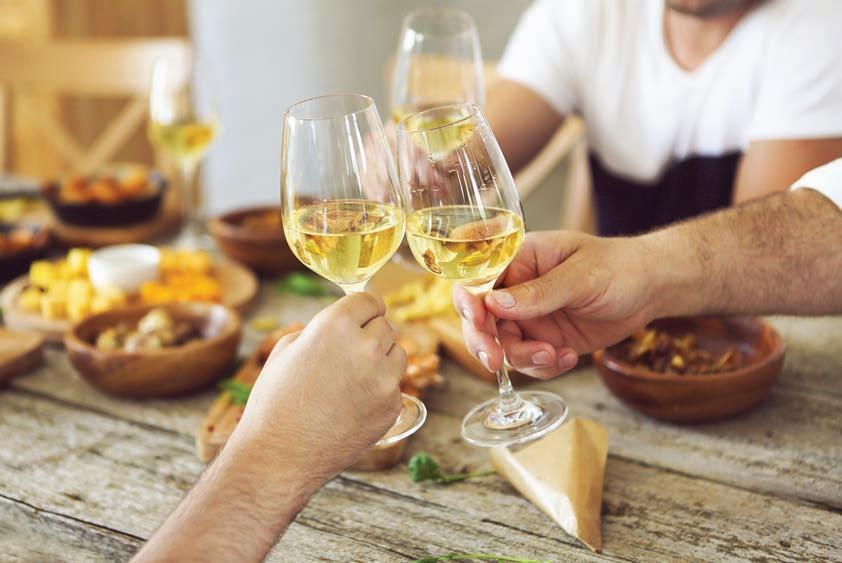
“So much more care is given to something new and special, and it shows,” says Irina. “I’m not sure that these should be stand-alone wines though. Perhaps they would be better in blends, as each has something special. It’s a great opportunity for us tasters, though, as we get a rare chance to taste them unblended.”
At another tasting the newbies are not so interesting. “I thought all of the Viogniers we tasted came from the same tank,” grumbles Christine.
Clive agrees. “Far too little avour and concentration.”
Viognier has been appearing for the last ve or six years at our tastings so hardly quali es as being a new variety, but it still remains something of a rarity.
“Remember how overblown these were at the beginning,” says Irina. “I think our winemakers are getting a handle on Viognier now. Today’s batch might be disappointing, but we’ve had some lovely examples.”
“ ose that show well are full of fruit— grapefruit, quince, pears and winter melons, mainly tropical,” says Clive.
“ at means properly ripe,” adds Irina.
“But,” says Clive, “too many producers are aiming at R60 a bottle and you don’t get anything exciting at that price point.”
Now here’s the thing—if you want to be stylish and trendy, drop the Sauvignon (so last year) and order a Viognier or a Roussanne. at should get them talking…
IS THERE A DRY IN THE HOUSE?
en on to white blends. It’s no secret that this is a stellar category. It inspires us and it’s clear that it’s inspiring the winemakers, too. So much creativity and hard work are going into cra ing these rather special wines. Clearly, the boys are enjoying playing with their new toys!
Claude sums it up like this. “ is is a tasting in two parts: wines with no avour and then the Rhône styles.” at’s a bit harsh, but those made with Rhône varieties stand out as superior in avour, concentration, style and persistence.
“ ere is a lot here with Sauvignon in the blend,” says Dave. “ ey seem to be wondering what they can add to make them better.”
“Our message is to make the Sauvignon itself better,” says Christine rmly. ere is one special niche for that pesky Sauvignon, however—in a blend with Sémillon, o en with oak, but not always. is of course is the classic white blend of Bordeaux, slowly evolved over decades by the Bordelais. ey have shown the way and it works.
On to those Rhône styles, the varieties mentioned earlier and o en blended here with some good Chenin. Unquestionably, they show thoughtful blending, avour intensity, good structure and, most importantly, beautiful balance. e broad sweep of the mouth- lling Rhônes is counter-balanced by the fresh and lively

WINES TASTED BY THE PANEL
DRY WHITE BLENDS
WINE-OF-THE-MONTH
CLUB: DeMorgenzon Maestro White 2016 ALSO LIKED: Allée Bleue Isabeau 2015, Leenders Baviaan White Blend 2018, KWV The Mentors Sauvignon Blanc Semillon 2015, Starke Conde Field Blend 2018
WINES LISTED IN ALPHABETICAL ORDER:
Alvi’s Drift Reserve Chenin Viognier Chardonnay 2017, Boplaas Cape Portuguese White Blend 2018, Cavalli Cremello 2016, Chamonix Reserve White 2016, Flagstone Treaty Tree Reserve White 2017, Glenwood Grand Duc 2016, Hermanuspietersfontein Stertswaai 2016, Kumala Zenith Chenin Blanc Chardonnay 2016, Lemberg Lady White 2015, Lomond SSV 2016, Mensa Chardonnay Pinot Noir 2018, Rietvallei Estéanna White Blend 2017, Saronsberg Earth in Motion 2018, Stofberg Sauvignon Blanc Semillon 2018, Waverley Hills Sauvignon Blanc Semillon 2018


Chenin.
“Mostly more than half of these blends is either Rousanne or Marsanne, but they’re not all the same, they are all so di erent,” notes Christine.
“ ey seem to get the most out of each component,” says Winnie. “ ese are not mixtures, but careful blends.”
“Chenin is the star of the show,” says Clive. “It seems to add to a blend.”
“Lovely wines, full of avour, always de nite and identi able,” says Dave. “Not just lekker.”
Claude picks up on the food angle. “So many di erent avours,” he says. “It makes them go so well with food. I didn’t nd that with the single varieties. I’d be happy to have a few of these with my lunch.” He’s probably thinking of the can dream up. ey have shown some exciting blends with mind-blowing components. When viewed on paper many seem bizarre, yet when tasted the pieces o en fall into place perfectly. Imagine, for example, Cabernet, Pinotage and Petit Verdot—terri c; or Cab, Shiraz, Petit Verdot, Tinta Barocca, Roobernet and Cab Franc—not so terri c.
Broadly speaking, certain styles are taking shape. ere are Cab-led or Pinotage-led blends and the now-notso-new Rhône styles that feature Shiraz, Grenache, Mourvèdre and Cinsaut, sometimes with a dash of white Viognier for fragrance.
Firstly, let’s get the gripes out of the way.
“Too many ordinary wines,” says a disappointed Clive.
“Some desperate blends. Adding together le overs in the cellar just doesn’t constitute a blend,” says Irina.

lemony herbal avours with sh—or olive and dry scrub with tender lamb.
He makes a further point though. “Plenty of interest and nice wines, but basically not up to Reserve wine standard.”
Winnie disagrees. “Not for me, I found quite a few Reserves—the Rhônes with a dash of Chenin, even the young ones. What we’re seeing are more adventurous blends with the new varieties, and Pinot Gris. Winemakers are experimenting a lot, and that’s a good thing.”
So there it is—a dry white blend for everyone, a pleasure for all, while for many it’s the top of the heap category.
Irina closes with: “ e Rhône varieties are heat resistant and drought resistant. at shows our guys are thinking forward and getting it right, too.”
TALKING RED BLENDS—IT’S ALL IN THE MIX
We’ve talked about this category a great deal—should any category be a “non” something, non-Bordeaux style for example, or should we simply call it Red Blends? Let us know what you think.
We’ve also talked a lot about the quality of red blends and just how creative and inspirational they can be. Some make perfect drinking for summer too, with lighter styles and lower alcohols, and can be lightly chilled for a picnic. ere are no formulae and no prescriptions, like for Bordeaux styles, so winemakers are limited only by what they have in the cellar and what they
WINES TASTED BY THE PANEL
NON-BORDEAUX BLENDS
WINE-OF-THE-MONTH
CLUB: Dornier Cocoa Hill Red 2016 ALSO LIKED: Bosman Family Adama Red 2017, Infinity The First XI The Belter 2016, Jean Daneel Signature Red 2015, Waverley Hills SMV 2013
WINES LISTED IN ALPHABETICAL ORDER:
Almenkerk Lace Selection 2014, Bersig Icarus Red 2014, Bezuidenhout Leenders Sielverkoper 2017, Bizoe RNW Blend 2017, Boplaas Ring of Rocks 2015, Bushmanspad Red Gold Blend 2017, Cavalli Night Mare 2015, Clos Malverne Heron’s Nest Cabernet Sauvignon Pinotage 2018, Ernie Els Big Easy Red Blend 2017, Frater Shiraz Mourvèdre Grenache 2014, Groote Post The Old Maris Blend 2017, Stellenrust Kleine Rust Pinotage Shiraz 2017, Truter Taste Shiraz Cabernet Sauvignon 2016, Waverley Hills SMV 2014
“And there are always those with too much tannin,” says Christine. e positives far outweigh the negatives, however.
Christine comes back with: “Such good fruit here. Winemakers are trying for drinkability. Smooth and juicy are the right words for these.”
“Quite a lot of innovation, and the wines are very drinkable,” from a very satis edlooking Claude.
“It’s here that they can experiment and come up with something new,” adds Winnie.
Greg also chimes in. “Lots of good ideas here,” he says, “and Pinotage is used in such a good way.”
Oh yes, our homegrown grape gives such nice rounded generosity to a blend it feels like coming home!
And again from Claude: “I scored these highly, I liked the juiciness especially the blends with Pinotage and then the more serious wines here, lovely to drink, too.”
Winnie joins in: “Some clever blends with Pinotage, which gives a juicy fruitiness.” en the Rhône-style blends, all led by Shiraz. Claude points out that even a good Shiraz is li ed by the addition of other varieties, usually Grenache. Christine agrees, saying they add interest and Irina says that Grenache seems better suited to be blended as it hasn’t shown that well as a stand-alone.
Christine sums up: “It’s always the Rhône varieties that shine through.”
A COOL CABERNET
Cabernet is arguably the world’s most favourite red–an all-seasons, all-round favourite. If you’re having a ne steak or roast beef it means a trip to the cellar to dig out a good Cab–come winter or summer.
Remember though, when the weather is hot you’ll need to chill your Cab down to about 16°C to get the balance the winemaker intended. A tepid red is to be avoided at all costs, the wine becomes volatile and loses fragrance and the balance is of course all wrong. O en ignored in our hot summers, it’s good practice generally to cool down your reds, and the lighter the body the cooler they can go.
Clive’s comment about our tasting of this category: “Very average wines, but I found some stunners. When there’s cassis and berries, they’re nice. ese are fruit-driven wines.”
Greg likes the more classic graphite character.
Dave is worried by tannins. “I don’t like tannins on Cab,” he says. “I found some good ones, but was disappointed by a few.”
Greg comes on more strongly. “I don’t think Cab should be made into a qua ng style. It should be sipped and served with good food. Turning it into a qua ng wine devalues the style.”
At another tasting, Winnie is impressed by the wines’ elegance. “ ey are all ripe and the balance of ripeness and elegance is very clever. Usually, with ripeness there’s a danger of ‘ripe and blowsy’, but to get a
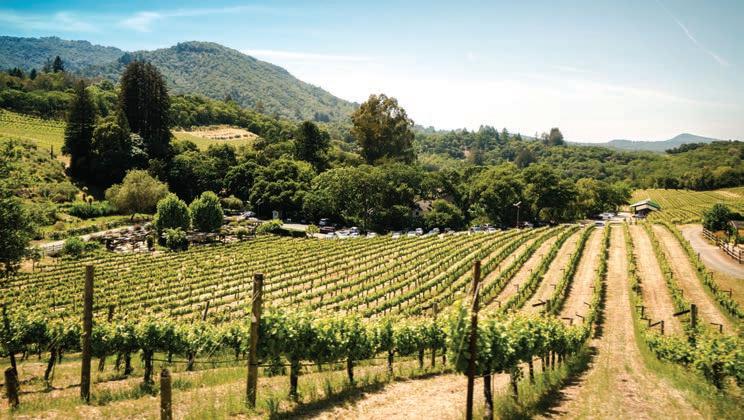

WINES TASTED BY THE PANEL
CABERNET SAUVIGNON
WINE-OF-THE-MONTH
CLUB: Flagstone Music Room Cabernet Sauvignon 2016 ALSO LIKED: Compagnies Wijn Cabernet Sauvignon 2017, Diemersfontein Cabernet Sauvignon 2017, Dornier Equanimity Cabernet Sauvignon 2016, Overhex Survivor Cabernet Sauvignon 2017
WINES LISTED IN ALPHABETICAL ORDER:
Boplaas Cabernet Sauvignon 2017, De Wet Cabernet Sauvignon 2017, Ernie Els Cabernet Sauvignon 2016, Flagstone Poetry Cabernet Sauvignon 2017, Glenelly Glass Collection Cabernet Sauvignon 2016, Kranskop Cabernet Sauvignon 2016, Lanzerac Cabernet Sauvignon 2016, Painted Wolf The Den Cabernet Sauvignon 2017, Saxenburg Private Collection Cabernet Sauvignon 2013, Simonsvlei Premium Cabernet Sauvignon 2016, Spier Vintage Selection Cabernet Sauvignon 2016, Stellekaya Cabernet Sauvignon 2015, Tanagra Cabernet Sauvignon 2016, Warwick Uitkyk Carlonet Cabernet Sauvignon 2014, Warwick Uitkyk Carlonet Cabernet Sauvignon 2016

degree of elegance is very smart.”
“I had very few low scores,” says Christine. “ e wines had very similar pro les, but the tannins are right, no hard tannins and there is a juiciness and some character.” ere’s a reason for those so er tannins. “ ey can’t get new oak barrels,” complains Winnie, referring to the fall of the rand.
“ ank goodness for that!” from Christine, ever sensitive to tough tannins, but adds, “that does not mean these are not for ageing. ose tannins are supple and it’s clever. You can drink these now, or keep them.”
Irina raises an interesting point. “I see winemakers are o en using that allowable 15% of other varieties to add extra interest to their Cabs. Isn’t that like admitting something is missing in your wine? What I’m missing is real Cab character.” When the weather is hot you’ll need to CHILL YOUR CAB DOWN TO ABOUT 16°C to get the balance the winemaker intended
ere’s a chorus of “no’s”— “they’re all so drinkable, easy and delicious.”
Irina goes down in ames. “Drinkable isn’t good enough,” she counters. “Water is drinkable. I want my Cab on a pedestal.”
More loud “no’s”.
So drinkable is good and desirable but not good enough for all.
And so it goes.

To purchase these wines and more, head to our website WWW.WINEOFTHEMONTH.CO.ZA
Linger longer AT BELLEVUE ESTATE
Visit our beautiful wine estate, located on Bottelary Road in Stellenbosch. Enjoy any of our wine pairing options, a pizza and wine pairing or relax on our restaurant’s oversized veranda with a glass of wine while the kids play.
Our restauarant menu caters for everyone’s taste, from delicious gourmet pizzas, to burgers and for those a little more hungry, a tender sirloin steak. Pair with any of our premium Bellevue wines and the perfect day awaits you!
Contact us on 021 865 2054 or email restaurant@bellevue.co.za to book WWW.BELLEVUE.CO.ZA
